Craft Traditions – Fly Tying
Using clever combinations of feathers, fur, and wire – a fly tyer does his or her best to imitate the look, flutter, wiggle, color, and silhouette of a bug or bait fish. This artistry is all in hopes of presenting an appetizing imitation for an unwary fish.
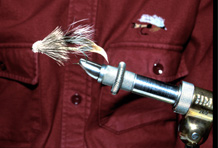
Fly tied by Ellis Hatch, Jr.
Much of fishing involves tossing a lure or live bait – like a worm or minnow-out to the river or lake, sometimes letting it stay in the water a while or reeling it back in right away. In fly fishing a specialized fishing rod and line are used to cast the fly far out to a specific spot in the water and then retrieve the fly by stripping in the line by hand. The idea is to catch the attention of the fish and get him to strike.
Fly fishing and fly tying are ancient arts and references to fly-fishing appear as early as 200 AD. The greatest advancements to the tradition were made during the 19th century in England. During this time, innovations in fishing rods, reels, and lines brought more people to the sport. About this time, an increased interest in the study of insects (entomology) also inspired fly fishermen to experiment with an even greater variety of fly patterns.
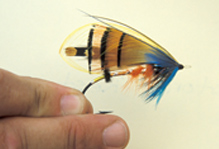
Fully dressed
Atlantic Salmon Fly
tied by Robert Wyatt.
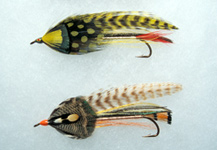
Two brightly colored
Rangeley style streamers
tied by Ellis Hatch, Jr.
for his grandchildren.
An additional factor affecting the fly tying tradition was a greater availability of exotic feathers. The 1800s were a time of great economic change in England. The British Empire was expanding its reach around the world and traders returned from countries in Asia, Africa, and South America with an amazing array of feathers. The fashion industry found uses for the feathers right way-mostly to decorate women's hats and elaborate gowns. However, it did not take long for the fly tyers to realize the potential of the feathers and incorporate them into new and increasingly artistic fly patterns.
A skilled angler is a student of nature and selects a fly that mimics what insects are doing in nature. Fly tyers organize their creations into five basic categories and hundreds of varieties within each group:
- Nymphs can be used anywhere in the water column and imitate a bug in its larval stage.
- Emerger patterns are used just beneath the water's surface and depict the transition between the aquatic form and the terrestrial stage of the bug.
- Dry flies are designed to float on the surface of the water, imitating an insect that has recently transformed into its terrestrial stage of life.
- Wet flies sink below the surface of the water to resemble submerged insects and baitfish. Streamer flies are used to imitate bait fish or simply act as attractors for predatory fish. The Rangeley style streamer was developed in New England. Many other successful patterns can be attributed to New Hampshire tiers.
- Classic Atlantic Salmon flies are considered by many to be the king of the ornamental flies and are works of art displayed and collected for their jewel-like beauty.
Tying flies requires an abundance of good supplies, a steady hand, and a patient disposition. A good fly tyer will tell you, half of the work is knowing how to find and select good materials. Fly tyers may spend nearly as much time collecting the feathers, fur, tinsel, and thread that go into a fly and keeping them all organized as they do tying flies.
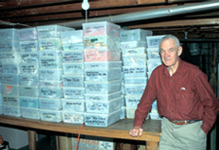
Ellis Hatch Jr. has been collecting
fly tying supplies
for years and keeps them
organized in bins.
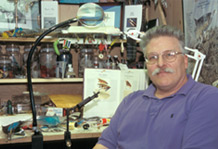
Fly tyer Mark Favorite
is surrounded by his tools
and supplies at his work bench.
The main tool for tying a fly is a vice. It attaches to a work table has an elevated clamp that holds the hook in place for the fly tyer. The fly tyer builds up the fly by holding bits of carefully selected feathers, fur, or tinsel along the shank of the hook and then securing each piece or layer in place by winding thread around a portion of the material and the hook The size and color of the thread is carefully selected and it is fed through a specialized bobbin.
An average fly used for fishing may have 4 to 10 steps. An expert fly tyer can produce 6 to 8 of these flies in an hour. A more elaborate dressed fly, like a Classic Atlantic Salmon Fly can have up to 30 or 40 steps and take several hours to complete.
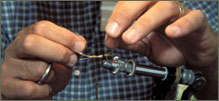
Bob Wyatt dressing a fly.
Most fly tyers are also fishermen. During the winter months, they spend their time indoors tying flies and telling fishing stories. When the first signs of spring emerge, they head out to their favorite rivers, lakes and ponds to try out their flys again. Many fishermen encourage the practice of "catch and release." This method of catching a fish, involves carefully removing the hook before harm comes to the fish and then and returning it to the body of water. This practice helps to keep fish stocks from being depleted.
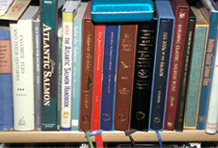
There are many sport fishing and fly tying clubs in New Hampshire, as well as other parts of the country. Books on fly tying are available at public libraries and bookstores. Many fly tyers create a reference library of their own. The largest collection of fly tying literature in the country, and perhaps the world, is in the Milne Special Collections and Archives, which is part of the University of New Hampshire in Durham.
For more information on fly tying and sport fishing, visit these websites:
Photo credit: Lynn Martin Graton
New Hampshire State Council on the Arts
19 Pillsbury Street - 1st Floor, Concord, NH 03301


